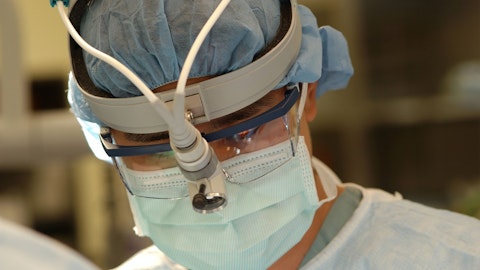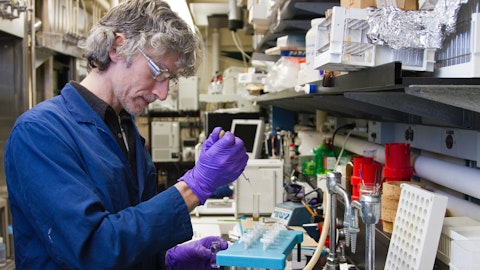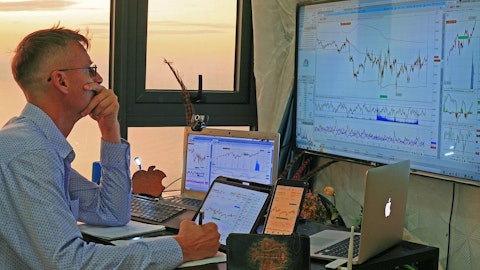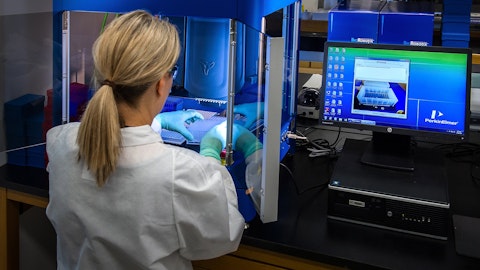Merck & Co., Inc. (NYSE:MRK) Q4 2022 Earnings Call Transcript February 2, 2023
Operator: Q4 Sales and Earnings Conference Call. At this time, all participants are on a listen-only mode until the question-and-answer session of today’s conference. This call is being recorded. If you have any objections, you may disconnect at this time. I would now like to turn the call over to Mr. Peter Dannenbaum, Vice President, Investor Relations. Sir, you may begin.
Peter Dannenbaum: Thank you, and good morning. Welcome to Merck’s fourth quarter 2022 conference call. Speaking on today’s call will be Rob Davis, Chairman and Chief Executive Officer; Caroline Litchfield, Chief Financial Officer; and Dr. Dean Li, President of Merck Research Labs. Before we get started, I’d like to point out a few items. You will see that we have items in our GAAP results, such as acquisition-related charges, restructuring costs and certain other items. You should note that we have excluded these from our non-GAAP results and provide a reconciliation in our press release. I would like to remind you that some of the statements that we make today may be considered forward-looking statements within the meaning of the Safe Harbor provision of the U.S. Private Securities Litigation Reform Act of 1995.
Such statements are made based on the current beliefs of Merck’s management and are subject to significant risks and uncertainties. If our underlying assumptions prove inaccurate or uncertainties materialize, actual results may differ materially from those set forth in the forward-looking statements. Our SEC filings, including Item 1A in the 2021 10-K, identify certain risk factors and cautionary statements that could cause the company’s actual results to differ materially from those projected in any of our forward-looking statements made this morning. Merck undertakes no obligation to publicly update any forward-looking statements. During today’s call, a slide presentation will accompany our speakers’ prepared remarks. The presentation, today’s earnings release, as well as our SEC filings are all posted to the Investor Relations section of Merck’s website.
With that, I’d like to turn the call over to Rob.
Rob Davis: Thanks, Peter. Good morning and thank you for joining today’s call. 2022 was an exceptional year for Merck. Our science-led strategy is working and I couldn’t be more proud of what our team has delivered scientifically, commercially and operationally. We are focusing on what matters and keeping the patient at the center of everything we do. We made significant progress in 2022 advancing our broad pipeline, with important internal success complemented by a portfolio of strategic acquisitions, collaborations and partnerships. We have moved with speed and urgency to drive strong progress and we have provided increased transparency into several of our long-term opportunities, including for GARDASIL, for our cardiovascular pipeline, and more recently, from newer assets that leverage our leadership position in Oncology.
We enter 2023 with even greater confidence that we are creating a sustainable engine that will bring forth innovation and generate value for both patients and shareholders over the long-term. Turning first to our results. The business is performing extremely well. The growth we have experienced in 2022 reflects a sustained track record of fundamental strength from our de-risked key growth pillars. We begin the year with confidence that we will maintain this strong underlying growth, after taking into account the significant impact LAGEVRIO had during the height of the pandemic last year and are pleased to reflect this in our 2023 initial guidance. Importantly, our pipeline is advancing with significant progress across several late-stage programs.
In Oncology, we have expansive research efforts, including our ambition to move treatment into earlier stage settings where there is higher potential for more favorable longer term outcomes for patients. In December, along with our partner Moderna, we were pleased to announce highly encouraging Phase 2 results for a personalized mRNA therapeutic cancer vaccine in combination with KEYTRUDA in the treatment of adjuvant melanoma. We are excited by the potential that this combination may have for patients across a range of tumor types. And last week, we were pleased to receive FDA approval for KEYTRUDA for the treatment of certain patients with early stage non-small cell lung cancer following resection and platinum-based chemotherapy, which Caroline and Dean will speak to.
In Cardiovascular, we are exploring candidates across a broad range of diseases and have made substantial progress from just one year ago. At the American College of Cardiology conference, we will present data from the STELLAR trial evaluating sotatercept in pulmonary arterial hypertension and from the Phase 2 trial of MK-0616, our oral PCSK9 inhibitor and we will also host an investor event to discuss these programs. In Vaccines, Instituto Butantan in Brazil, with whom we are collaborating for vaccine development, reported very encouraging topline results for their candidate for the prevention of dengue. These data will inform future development of our dengue vaccine, V181, and our efforts to address this critical public health challenge. Finally, through our business development efforts, we brought in four programs which will have phase three trial starts in 2023 and which have the opportunity to contribute meaningful growth during the latter half of this decade and into the next.
We are following our disciplined approach to business development and we will act when scientific opportunity and value align. We have more to do, but I feel very good about the progress we made in 2022 and we believe that all of these efforts will lead to real benefits for patients and in turn for shareholders. We enter 2023 with confidence in the innovation engine we are building and our ability to deliver sustainable value for patients well into the next decade. We will continue to execute on our de-risked assets and act with urgency to advance and grow our pipeline. We are doing all of this with an approach to sustainability that is closely aligned to our overall business strategy. I am very confident in the short- and long-term outlook of our company, and I look forward to providing future updates.
With that, I will turn the call over to Caroline.
Caroline Litchfield: Thank you, Rob. Good morning. As Rob noted, 2022 was an exceptional year for our company. We delivered excellent topline growth of 22% driven by strength across our key pillars of Oncology, Vaccines and Hospital, as well as a significant contribution from LAGEVRIO. Our Animal Health business delivered strong operational growth, which was offset by foreign exchange. These results are a testament to the profound impact our medicines and vaccines are having on patients globally, which are enabled by our dedicated teams who are executing with excellence to deliver these important innovations. We are confident in the health of our business and in our outlook for continued strong underlying growth. Now, turning to our fourth quarter results.
Total company revenues were $13.8 billion, an increase of 2%. Excluding the impact from foreign exchange, the business delivered strong operational growth of 8%. The remainder of my revenue comments will be on an ex-exchange basis. Our Human Health and Animal Health businesses continued their strong growth increasing 9% and 6%, respectively. Now, turning to the fourth quarter performance of our key brands. In Oncology, KEYTRUDA grew 26% to $5.5 billion, driven by strong global demand for in-line indications, as well as continued global expansion from new approvals. In the U.S., KEYTRUDA grew across all key tumor types and continues to benefit from uptake in earlier-stage cancers, including triple negative breast cancer, as well as in certain types of renal cell carcinoma and melanoma.
KEYTRUDA continues to have a profound impact on patients, including in earlier-stage cancers, where there is greater potential for better outcomes. We are excited by the recent approval of KEYNOTE-091, which represents KEYTRUDA’s seventh indication in earlier-stage cancers. Early lung cancer detection and screening remain an important unmet need. It is our ambition, along with others to improve lung cancer screening rates to levels similar to other tumor types, such as breast, where screening programs are more routine. While we are committed to addressing this unmet need, we anticipate a more gradual near-term uptake from this indication. In the metastatic setting, KEYTRUDA maintains its leadership position in non-small cell lung cancer, which gives us confidence that we are well-positioned to positively impact patients in the earlier setting.
Outside the U.S., KEYTRUDA growth continues to be driven by uptake in metastatic indications, including non-small cell lung cancer, head and neck cancer and renal cell carcinoma, as well as recent launches in earlier-stage cancers, including certain types of high-risk, early-stage triple negative breast cancer and renal cell carcinoma. Lynparza maintains its leadership of the PARP inhibitor class. Alliance revenue grew 14% primarily due to continued demand in certain patients with high-risk, early-stage breast cancer. Lenvima alliance revenue grew 9%, driven by increased uptake in the treatment of certain patients with advanced renal cell carcinoma and advanced endometrial cancer in the U.S. Lastly, WELIREG is performing in-line with our expectations and we are proud of the impact it is having on adult patients with certain VHL-associated tumors.
Our Vaccines portfolio delivered growth, with GARDASIL increasing 6% to $1.5 billion, driven by strong demand in major ex-U.S. markets, particularly China. In the U.S., sales decreased primarily due to CDC purchasing patterns. Vaccines sales also benefited from the pediatric launch of VAXNEUVANCE, which is off to an encouraging start, with revenues also benefitting from inventory stocking. In our Hospital Acute Care portfolio, BRIDION sales grew 7%, driven by an increase in market share among neuromuscular blockade reversal agents and an increase in surgical procedures. Hospital Acute Care sales also benefitted from the resupply of ZERBAXA, which started in the fourth quarter of 2021. Our Animal Health business delivered another solid quarter, with sales increasing 6% reflecting strategic price actions and volume growth.
Livestock sales grew 12% driven by increased demand in ruminants and poultry products. Companion animal sales were negatively impacted by supply challenges for certain vaccines and a reduction in vet visits in October, which improved during the quarter. I will now walk you through the remainder of our P&L and my comments will be on a non-GAAP basis. Gross margin was 75.7%, an increase of 0.9 percentage points due to favorable product mix and foreign exchange. Operating expenses increased 8% to $5.7 billion, reflecting increased investments to support our portfolio and growing pipeline. Other income was $86 million, reflecting the return on pension plan assets and capitalized interest, which was largely offset by net interest expense. Our tax rate was 15.6%.
Taken together, earnings per share were $1.62. Turning now to our 2023 non-GAAP guidance. The strength across our key pillars is expected to continue into this year. We project revenue to be between $57.2 billion and $58.7 billion, including approximately $1 billion from LAGEVRIO. Excluding the negative impact of LAGEVRIO and an approximate 2% negative impact from foreign exchange using mid-January rates, we expect strong underlying revenue growth of 7% to 10%. Our gross margin is expected to be approximately 77%. Operating expenses are assumed to be between $23.1 billion and $24.1 billion, which includes $1.4 billion of research and development expenses related to our acquisition of Imago and the expansion of our collaboration with Kelun Biotech.

Photo by raimond klavins on Unsplash
As a reminder, our guidance does not assume additional significant potential business development transactions. Other Income is anticipated to be approximately $250 million. We assume a full year tax rate between 17% and 18% and approximately 2.55 billion shares outstanding. Taken together, we expect EPS of $6.80 to $6.95. This range includes a negative impact from foreign exchange of approximately 4% using mid-January rates. Our guidance reflects confidence in the continued strong growth across Oncology, Vaccines and Animal Health. As you consider your models, there are a few items to keep in mind. On revenues, we are confident in our ability to drive strong growth of GARDASIL, particularly in international markets. Global immunization levels remain low, which creates a tremendous opportunity to benefit more patients and we are improving supply, which positions us well to support the significant demand we are experiencing today and expect over the long-term for this vaccine that prevents HPV-related cancers.
Other Revenue is projected to decline significantly, primarily reflecting a smaller planned benefit from revenue hedges following the U.S. dollar strength last year, which resulted in an approximate $800 million benefit in 2022. Other revenue is also expected to be lower due to the discontinuation of third-party manufacturing sales to Johnson and Johnson. On the rest of the P&L, we project a shift from other expense to other income, which is primarily attributable to an assumption that there will be no pension settlement cost, as well as an expectation of lower net interest expense and higher joint venture equity income. This benefit is more than offset by an increase in the estimated tax rate due to the unfavorable impact of the R&D capitalization provision, as well as an approximate 1 percentage point impact related to Imago.
Now shifting to capital allocation, where our priorities remain unchanged. We will continue to prioritize investments in our business to drive near- and long-term growth. We are excited about the significant progress our team has made to advance and augment our pipeline in 2022. In 2023, we will continue to invest in opportunities that will address important unmet medical needs and drive the next wave of growth for our company, including the initiation of many late-stage clinical trials across a broad set of novel candidates. We remain committed to our dividend, with the goal of increasing it over time. We will continue to pursue the most compelling external science through value-enhancing business development to augment our internal pipeline and will invest appropriately to maximize the potential of our R&D programs.
Given the strength of our business and balance sheet, we plan to resume share repurchases, while ensuring we maintain ample capacity to pursue additional business development, which is the higher priority. To conclude, we enter 2023 confident in our ability to execute on the important opportunities we have to deliver innovation to patients and sustain the strong underlying growth of our business well into the future. With that, I’d now like to turn the call over to Dean.
Dr. Dean Li: Thank you, Caroline. Today, I will provide notable updates since our last earnings call. We continue to make significant advancements and achieve important regulatory milestones. The fourth quarter marks the end of a successful year with progress made across Oncology, Vaccines, Infectious Diseases and Cardiology. Let me start with Oncology. We remain committed to transforming the landscape of cancer therapy with an ongoing focus on treating earlier stages of disease. We are pleased by the recent approval of KEYTRUDA for the adjuvant treatment of adult patients with Stage Ib, II or IIIa non-small cell lung cancer following resection and platinum-based chemotherapy based on the results of KEYNOTE-091. This approval provides for the very first time an adjuvant immunotherapy option for this patient population with Stage Ib disease and regardless of PD-L1 status.
Beyond KEYNOTE-091, we have additional ongoing studies in earlier stages of non-small cell lung cancer including, KEYNOTE-671 evaluating KEYTRUDA with platinum doublet chemotherapy as neoadjuvant followed by adjuvant therapy in resectable Stage II, IIIa and IIIb disease, KEYNOTE-867 evaluating KEYTRUDA in patients undergoing stereotactic body radiotherapy with unresected Stage I or II disease, and KEYLYNK-012 studying KEYTRUDA in combination with Lynparza in Stage III disease. These trials are all part of our broader effort to treat earlier stages of cancers and further improve patient outcomes across tumor types, such as melanoma. Together with Moderna, we announced positive Phase 2 results for V940/mRNA-4157, in combination with KEYTRUDA for the adjuvant treatment of Stage III and IV melanoma in patients with high risk of recurrence following complete resection.
The combination demonstrated a statistically significant and clinically meaningful improvement in recurrence free survival versus KEYTRUDA alone. This investigational personalized neoantigen therapy utilizes mRNA technology and is specifically tailored to target the unique mutational signature of each patient’s tumor. We plan to discuss the results with regulators and initiate Phase 3 trials in multiple tumors this year. Detailed results will be presented at an upcoming medical meeting. We also announced positive results from the Phase 3 KEYNOTE-966 trial evaluating KEYTRUDA in combination with chemotherapy. This trial demonstrated an improvement in overall survival for the first-line treatment of patients with advanced or unresectable biliary tract cancer.
In addition, we announced positive topline results from the Phase 3 KEYNOTE-859 trial evaluating KEYTRUDA in combination with chemotherapy for the first-line treatment of patients with HER2-negative locally advanced unresectable or metastatic gastric or gastro-esophageal junction adenocarcinoma. In November, we announced the acquisition of Imago Biosciences, which closed last month. Imago’s lead candidate, bomedemstat, is a potentially first-in-class orally available lysine-specific demethylase 1 inhibitor. It is currently being evaluated in multiple Phase 2 clinical trials for the treatment of essential thrombocythemia, myelofibrosis and polycythemia vera. The combined team is now focused on continuing to advance the ongoing clinical development programs.
At the American Society of Hematology annual meeting, data were presented from multiple pipeline candidates including, favezelimab, our anti-LAG3 antibody, zilovertamab vedotin, an antibody drug conjugate, targeting ROR-1, nemtabrutinib, our oral reversible, non-covalent BTK inhibitor, as well as KEYTRUDA. Updated Phase 2 data for bomedemstat in essential thrombocythemia and advanced myelofibrosis were also presented. We continue to deliver on our regulatory strategy. In the European Union, along with our partner, Astra Zeneca, we announced the approval for Lynparza, in combination with abiraterone and prednisone, for the treatment of certain patients with metastatic castration-resistant prostate cancer based on the results of the PROpel trial.
In China, based on the results of KEYNOTE-522 and KEYNOTE-394, we received approvals for KEYTRUDA in neoadjuvant / adjuvant high-risk, early-stage triple negative breast cancer and hepatocellular carcinoma, respectively. With our partners, Astellas and Seagen, we announced the FDA has accepted supplemental biologics license applications for KEYTRUDA with PADCEV, an antibody-drug conjugate targeting Nectin-4, for the first-line treatment of certain patients with locally advanced or metastatic urothelial cancer who are not eligible to receive cisplatin-containing chemotherapy. The agency set a PDUFA date of April 21, 2023 for each application. Building on the clinical benefits observed with KEYTRUDA in combination with chemotherapy and antibody drug conjugates, we have focused on augmenting our tissue targeting candidates through business development.
We announced the expansion of our agreement with Kelun Biotech with the addition of up to seven preclinical antibody drug conjugates. The collaboration leverages technology with the potential to yield a new generation of candidates designed to precisely target and deliver potent anticancer agents to the tumor site. This follows previously disclosed agreements for two clinical stage candidates, including MK-2870, an investigational TROP2 targeting ADC we are planning to advance into Phase 3 trials this year. We also expanded our collaboration with PeptiDream to include the discovery and development of peptide drug conjugates. This technology potentially provides for improved permeability and drug selectivity in targeting tumor tissue. Next to our Vaccines portfolio.
We were encouraged by the progress scientists and clinicians at the Instituto Butantan in Brazil made in developing a single dose dengue vaccine candidate for registration in Brazil. We are collaborating with the team there to conduct a detailed analysis of these positive, topline Phase 3 results to determine next steps for our own dengue vaccine candidate, V181, currently in Phase 2 development. Merck’s goal is to make V181 available outside of Brazil for populations at-risk for dengue. As Caroline noted, we are receiving positive feedback from the field regarding the recent launch of VAXNEUVANCE in the pediatric setting and remain confident in our population specific strategy for the prevention of pneumococcal disease. VAXNEUVANCE offers strong protection, including in the first year of life, with robust immunity across all shared and unique serotypes.
This is important because the incidence of invasive pneumococcal disease is greatest in the first year of life for children. Also, we are on track and look forward to the Phase 3 results from our V116 program for the protection of adults this year. We, along with others in the industry, are making a real impact in our goal to help reduce cancer incidence. It was noteworthy that the American Cancer Society’s recently published annual report on cancer facts and trends included the remarkable observation that there has been a 65% reduction in cervical cancer incidence in women 20 years old to 24 years old from 2012 through 2019. It is this type of finding that further reinforces Merck’s commitment to bringing forward treatment and prevention options to help patients with this devastating disease.
As part of this commitment, we are encouraged by the role GARDASIL continues to play in helping to prevent certain HPV related cervical cancers. Turning to the broader portfolio. With the continued impact of COVID-19 in China, treatment options are urgently needed to help reduce the incidence of disease and burden on healthcare systems. We were pleased LAGEVRIO was granted conditional marketing authorization by China’s National Medical Products Administration in December, for use in adult patients who have mild to moderate COVID-19 infection and a high risk of progressing to severe cases. I wish to reinforce something Rob mentioned. Please mark your calendars for March 6th where we will present detailed findings of the Phase 3 STELLAR trial evaluating sotatercept in patients with pulmonary arterial hypertension and the Phase 2 results for MK-0616, our oral PCSK9 inhibitor, at the American College of Cardiology in conjunction with the World Congress of Cardiology meeting in New Orleans.
We will also host a live investor event to answer your questions. We look forward to bringing sotatercept as an important treatment option to patients and are currently working towards submission of the data from the STELLAR trial. We are in discussions with the FDA about submission of the data on a rolling basis, which is likely to result in a potential approval in early 2024. As we close out 2022, it is important to highlight that over the course of the year we made strong progress across therapeutic areas, modalities, stages of development and multiple business development transactions. In Oncology, we obtained several important regulatory approvals globally for KEYTRUDA and Lynparza, as well as advanced a number of programs evaluating earlier stage cancer regimens.
In Vaccines, we received an important approval in pediatrics for VAXNEUVANCE. In addition, we were granted expanded authorizations in China and active recommendations were reinstated in Japan for GARDASIL. In HIV, we resumed our clinical development program for islatravir. And finally in cardiovascular disease, we made significant progress across our pulmonary arterial hypertension and hypercholesterolemia programs. Taken together, we continue to deliver on our strategy of advancing promising candidates across multiple therapeutic areas. We have strong momentum across our pipeline and look forward to providing further updates on our progress in 2023. And now I will turn the call back to Peter.
Peter Dannenbaum: Thanks, Dean. Kelly, we are ready to take questions now. We intend to end the call at 9 sharp this morning, so request that analysts limit themselves to one question, please.
See also 12 Best Low Priced Dividend Stocks To Buy and 12 Cheap Biotech Stocks To Buy .
Q&A Session
Follow Merck Sharp & Dohme Corp. (NYSE:MRK)
Follow Merck Sharp & Dohme Corp. (NYSE:MRK)
Operator: Our first question is from Carter Gould from Barclays. Carter, your line is open.
Carter Gould: Hi. Thank you for taking the question. Maybe just you made some comments around sort of uptake in the adjuvant setting after the most recent label update. Can you maybe just sort of set expectations there and does that comment reflect any sort of assumptions around when we might see mature data from the PEARLS study potentially this year? Thank you.
Dr. Dean Li: Yeah. So I believe you are speaking about KEYNOTE-091. So I just want to take a broad view and then today view and the tomorrow view. So I would just count that the American Cancer Society in 2023, it’s really remarkable. They suggest that for between 1991 and 2023, there’s a massive reduction in lung cancer of 58%, 36% and KEYTRUDA has been critical in that story and now we are moving to early lung. The label is broad. It is regardless of PD-L1 and it reflects the clinical trial, where we demonstrated a 27% reduction. We are pushing into these earlier lines with other trials. But I think for what we need to set for is two things. We need to make it much more easier with scientific innovation other means to get subcu, I mean, to get KEYTRUDA and that’s why we are very eager to push our subcu pembrolizumab with to face through this year.
But we also need to do a lot to improve adherence to established guidelines, which currently only have 6% or so of individuals actually who should be screened in the United States. So, I think, with that, we have work to do in relationship to really taking this important advance and making it broadly available through to individuals who should be getting screened.
Rob Davis: So, Carter, maybe I can just add on a little bit about the commercial opportunity. As Dean said, this will be a slower ramp, because we have to drive more people to get diagnosed early so that we can get them the care they need. But just to give you some sizing of this. If you look at 2023, there are about 230,000 people who were diagnosed with lung cancer in U.S. and the majority of that group was not diagnosed until they were in the metastatic setting. So if you think about it from a minority perspective, we would estimate about 120,000 people in the early-stage setting, of which only a quarter will have a section or have surgery and be in the Stage Ib to IIIa, which is what our label indicates. So you are looking at about 30,000 patients who would be the addressable population and then obviously, of that group, historically, only about half of those patients have gone on to receive treatment in the form of chemotherapy or IO.
So that’s obviously something we hope to change as we go forward, because we think the outcome will show that if you are resected, you should pursue KEYTRUDA in that setting and it’s our goal over time not only to drive more patients in that segment. But, obviously, the more people we can get diagnosed early pre-metastatic, then actually we will expand the population over time. So we see this as a meaningful opportunity long-term that is going to take us time to ramp as we work to change the paradigm that’s existed in the past. Thank you, Carter. Next question, please, Kelly?
Operator: Our next question is going to come from Andrew Baum from Citi.





